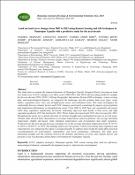Options
Land use land cover changes from 2003 to 2023 using Remote Sensing and GIS techniques in Niamotpur Upazila with a predictive study for the next decade
Journal
Romanian Journal of Ecology & Environmental Chemistry
ISSN
2668-8530
Date issued
2024-12-23
Author(s)
Hossain, Nazmul
Stamford University Bangladesh
Adnan, Jannatul
Chowmuhani Govt. S A College, Bangladesh
Jahin Mim, Tasmia
BRAC University
Binte Zohir, Ayesha
Bangladesh University of Professionals
Ahmad, Iftakhar
University of Dhaka
Zaman, Ahmadullah
Khulna University of Engineering and Technology
Hasan, Mehedi
Chittagong University of Engineering & Technology
Hossain, Noor
University of Dhaka
DOI
10.21698/rjeec.2024.203
Abstract
<jats:p>This study aims to examine the temporal dynamics of Niamotpur Upazila, Naogaon District, focusing on Land Use Land cover (LULC) changes over thirty years (2003,2013, and 2023) and providing predictive insights for the next decade (2024÷2033). Utilizing Geographic Information System (GIS) techniques, remote sensing data, and meteorological datasets, we categorize the landscape into five primary land cover types: water bodies, vegetation cover, bare soil, drought-prone areas, and settlement areas. This study investigates the relationship between climatic factors and LULC changes, particularly examining the impacts of precipitation and temperature fluctuations on drought-prone areas. From 2003 to 2023 bare soil consistently decreased, while deep vegetation significantly increased, indicating improved land health. Urban areas and light vegetation peaked in 2013 but declined by 2023. Water bodies decreased until 2013, then increased by 2023. Drought-prone areas saw a drastic decrease in extreme drought and a substantial increase in no-risk areas. Climatic data showed minor fluctuations in average temperatures and precipitation: the average maximum temperature slightly decreased, while minimum temperatures and precipitation had small variations. Predictions for the next decade forecast a gradual rise in the average maximum temperature from 29.758 °C in 2024 to 29.830 °C in 2033. The findings underscore the positive trend of increasing deep vegetation and reducing bare soil, enhancing the region’s ecological health. To address these trends the study offers practical recommendations for policymakers, stakeholders, and local communities. Ultimately, this study gives substantial insights into the relations between the dynamic alterations of LULC and climatic factors and presents a way of achieving a better future environment for Niamotpur Upazila.</jats:p>
Files
Loading...
Name
Articol 03 Full.pdf
Size
702.79 KB
Format
Adobe PDF
Checksum
(MD5):7155923c3cefe9aaa8d941585a3ae0fd